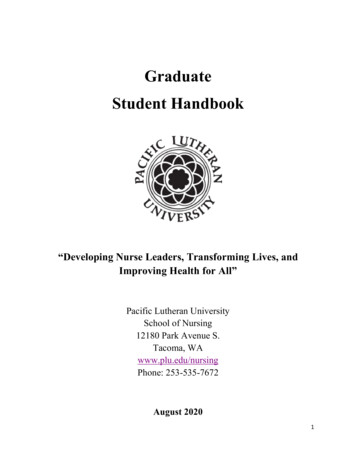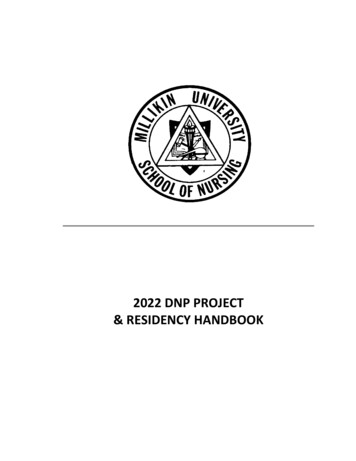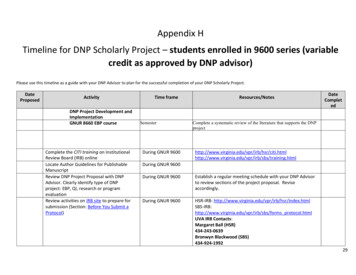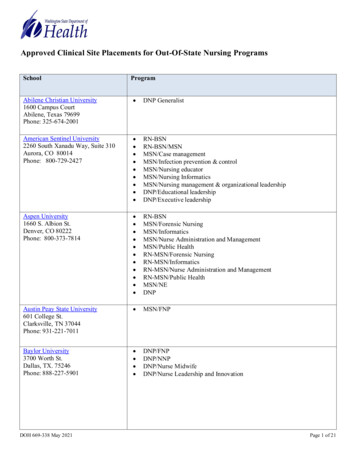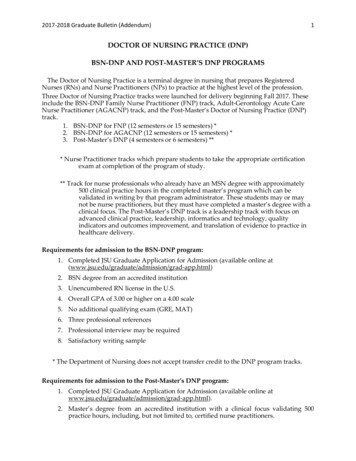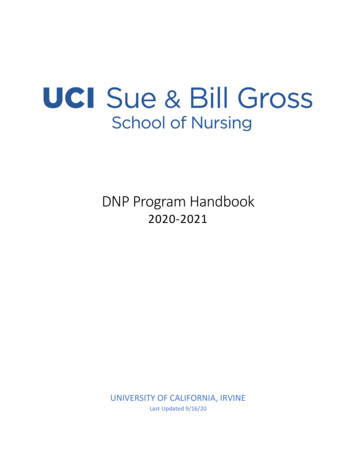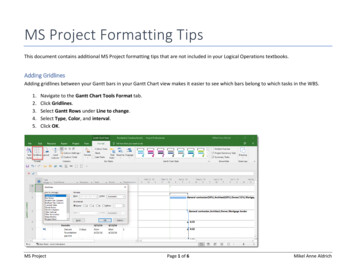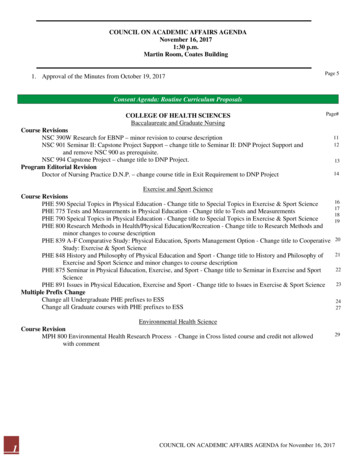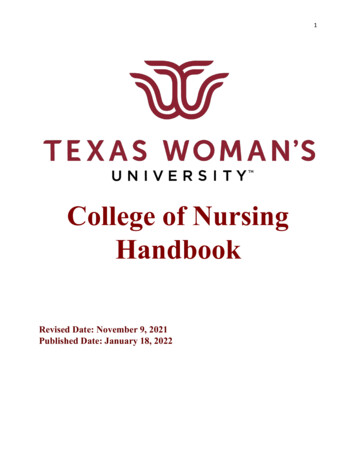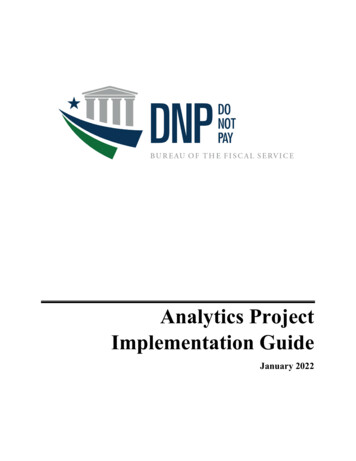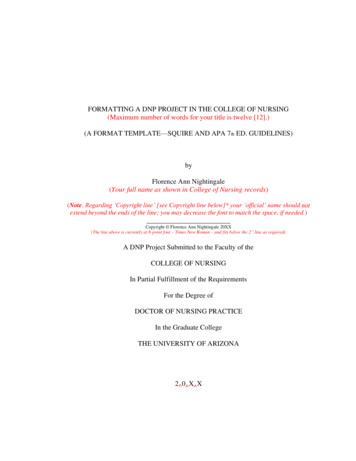
Transcription
FORMATTING A DNP PROJECT IN THE COLLEGE OF NURSING(Maximum number of words for your title is twelve [12].)(A FORMAT TEMPLATE—SQUIRE AND APA 7th ED. GUIDELINES)byFlorence Ann Nightingale(Your full name as shown in College of Nursing records)(Note. Regarding ‘Copyright line’ [see Copyright line below]* your ‘official’ name should notextend beyond the ends of the line; you may decrease the font to match the space, if needed.)Copyright Florence Ann Nightingale 20XX(The line above is currently at 8-point font – Times New Roman – and fits below the 2” line as required)A DNP Project Submitted to the Faculty of theCOLLEGE OF NURSINGIn Partial Fulfillment of the RequirementsFor the Degree ofDOCTOR OF NURSING PRACTICEIn the Graduate CollegeTHE UNIVERSITY OF ARIZONA2 0 X X
2THE UNIVERSITY OF ARIZONAGRADUATE COLLEGEAs members of the DNP Project Committee, we certify that we have read the DNP projectprepared by [Enter Student Name –remove brackets and italics after entering information], titled[Enter DNP Project Title] and recommend that it be accepted as fulfilling the DNP projectrequirement for the Degree of Doctor of Nursing Practice.Date:[Committee Chair Name]Date:[Committee Member Name]Date:[Committee Member Name]Final approval and acceptance of this DNP project is contingent upon the candidate’s submissionof the final copies of the DNP project to the Graduate College.I hereby certify that I have read this DNP project prepared under my direction and recommendthat it be accepted as fulfilling the DNP project requirement.Date:[Committee Chair Name]DNP Project Committee Chair[Academic Department]Updated May 15, 2020
3ACKNOWLEDGMENTS(Optional)(Heading: Centered, in CAPS, no bolding)(Margins: Top 1.5”; Bottom 1”; Left 1”; Right 1”)(Section may be single or double spaced)(One page maximum)Updated May 15, 2020
4DEDICATION(Optional)(Heading: Centered, in CAPS, no bolding)(Margins: Top 1.5”; Bottom 1”; Left 1”; Right 1”)(Section must be double spaced)(One page maximum)Updated May 15, 2020
5Table of Contents Guidelines (Model Below)(Required)(Heading: Centered, in CAPS, Bolding)(Margins: Top 1.5”; Bottom 1”; Left 1”; Right 1”) The Table of Contents heading and anything that comes BEFORE the Table of Contentsshould not be listed in the actual Table of Contents. In most cases the first item in theTable of Contents will be the Abstract unless you have a List of Tables and/or a List ofFigures; in that case, those are the first items on your Table of Contents.Include the heading TABLE OF CONTENTS at the top of the first page of this section(as shown above, Boldface), and TABLE OF CONTENTS - Continued (no bolding) oneach continuing page (as shown on next page).You must include dot leaders “.” from headings to page numbers(template shown below).Note. Page numbering following dot leaders MUST be aligned with the right-handmargin.Indent each level of subheading 1 tab (0.5 inch) from the level above (template shownbelow).MUST BE FOLLOWED: Headings in the Table of Contents must exactly match theheadings used in the body of your paper and should be typographically the same (e.g.,same type font and style, capitalization, boldface; template shown below).Use all CAPITAL LETTERS for major section headings.o Major sections are INTRODUCTION, METHODS, RESULTS, andDISCUSSION (template shown below).Use APA 7th ed. formatting for subheadings (see p. 48, Table 2.3 in APA 7th Manual forhow to format headings) within each major section (e.g., Background Knowledge,Significance, etc.; template shown below).Each Appendix must have its own letter designation and title. Appendixes are majordivisions. In the Table of Contents, the Appendix title appears in CAPS on the leftmargin at the same level of importance as chapter headings (template shown below).The Table of Contents should flow as much as possible, keeping sections and headingstogether. The sample as shown below is separated by page breaks.Headings and subheadings (listed below Major Headings) in the Table of Contents reflectthose used in the NURS 922 rubric and are based on the Revised Standards for QualityImprovement Reporting Excellence (SQUIRE 2.0; 2015).o Note. Not every heading and subheading below is necessary in every project,except for Major Headings (i.e., BOLD and CAPITAL LETTERS).Updated May 15, 2020
6TABLE OF CONTENTSLIST OF FIGURES (Required if document includes graphs, pictures, models, drawings, etc.) .LIST OF TABLES (Required if document includes tables for listing numbers, raw data, etc.) .ABSTRACT.INTRODUCTION (Why did you start?).Background Knowledge/Significance (Level 1 Subheading) .Local Problem .Intended Improvement .Project Purpose (Level 2 Subheading) .Project Question .Project Objectives .Theoretical Framework .Literature Synthesis .Evidence Search .Comprehensive Appraisal of Evidence .Strengths of Evidence .Weaknesses of Evidence .Gaps and Limitations .METHODS (What did you do?) .Project Design.Model for Implementation .Setting and Stakeholders .Planning the Intervention.Participants and Recruitment .Consent and Ethical Considerations .Data Collection .Data Analysis .RESULTS (What did you find?) .Outcomes .Updated May 15, 2020
7TABLE OF CONTENTS – ContinuedDISCUSSION (What does it mean?) .Summary.Interpretation .Implications (Practice, Education, Research and Policy) .Limitations .DNP Essentials Addressed .Conclusions .Plan for Sustainability .Plan for Dissemination .Funding (Optional) .APPENDIX A:SITE APPROVAL/AUTHORIZATION LETTER .APPENDIX B:CONSENT DOCUMENT (DISCLOSURE FORM, CONSENT FORM,ETC.) .APPENDIX C:RECRUITMENT MATERIAL (RECRUITMENT FLYER, RECRUITMENTEMAIL, ETC.) .APPENDIX D:EVALUATION INSTRUMENTS (STUDENT CREATED DATACOLLECTION TOOLS – SURVEYS, QUESTIONNAIRES, INTERVIEWQUESTIONS, ETC.) .APPENDIX E:PARTICIPANT MATERIAL (INSTRUCTIONAL VIDEO, WRITTENGUIDELINES, ANYTHING THE PARTICIPANT WILL SEE OR HEAR) .APPENDIX F:CHART AUDIT FORMS .APPENDIX G:PROJECT TIMELINE .APPENDIX H:LITERATURE REVIEW GRID.APPENDIX I:OTHER DOCUMENTS AS APPLICABLE TO THE PROJECT (SUCH ASBUDGET) .REFERENCES .Updated May 15, 2020
8LIST OF FIGURES(The heading must be centered at the top margin of the page (in CAPS, no bolding)(Margins same as body of paper - Top 1.5”; Bottom 1”; Left 1”; Right 1”)Include the heading LIST OF FIGURES at the top of the first page of this section (centered asshown above), and LIST OF FIGURES - Continued (centered at the top of each page) forsubsequent pages.Within your paper, material is numbered in sequence (whole numbers), Figure 1, Figure 2, etc.(template shown below) and single spacing can be used for figure titles and captions.Note. Figure titles (and captions) are placed above the figure. Figures are placed within thedocument where they are first mentioned (see end of this document for figure format sample)Figure 1. Title of Figure 1 as It Appears Within Your Paper .Figure 2. Title of Figure 2 as It Appears Within Your Paper .(See sample Figure at end of document; you may include as many figures as you need.)Updated May 15, 2020
9LIST OF TABLES(The heading must be centered at the top margin of the page (in CAPS, no bolding)(Margins same as body of paper - Top 1.5”; Bottom 1”; Left 1”; Right 1”)Include the heading LIST OF TABLES at the top of the first page of this section (centered, asshown above), and LIST OF TABLES - Continued (centered at the top of each page) forsubsequent pages.Within your paper, material is numbered in sequence (whole numbers), Table 1, Table 2, etc.(template shown below) and single spacing can be used for table titles and headings.Note. Table titles (and headings) are placed above the table. Tables are placed within thedocument where they are first mentioned (see end of this document for table format sample).Table 1. Title of Table 1 as It Appears Within Your Paper .Table 2. Title of Table 2 as It Appears Within Your Paper .(See sample Table at end of document; you may include as many tables as you need.)Updated May 15, 2020
10ABSTRACT(Required)(Double-spaced paragraphs)(The heading ABSTRACT must be centered at the top margin of the page (in CAPS, no bolding)(Margins same as body of paper - Top 1.5”; Bottom 1”; Left 1”; Right 1”)Note. For your submission profile to the Graduate College (to be included in the abstractarchive), an extra copy of the abstract (minimum of 150 words, maximum of 350 words) must bepasted or typed in during the submission process. Anything beyond this word limit will betruncated.1. The abstract should summarize your work. It allows readers to quickly review the mainpoints and purpose of your paper.2. Abbreviations and acronyms used in the paper should be defined in the abstract.3. The abstract for a DNP project should be a minimum of 150 words and a maximum of 350words.4. When you submit your DNP project final draft to the Graduate College, you will be requiredto include an extra copy of the abstract for storage in the online abstract archive. The textformat and style remain the same for both versions (i.e., versions for both abstract archiveand final document. Note. It might be necessary to paste or type the archive copy in during the submissionprocess.5. Use the following headings in your abstract (see example on the next page): Purpose Background Methods Results Conclusions6. See sample abstract on next page. The sample is one model; talk with your DNP project committee chair if you would liketo format the headings slightly differently (e.g., with colons instead of periods, indented,not bold, etc.).o Note. Permission to adapt the sample abstract for use in this document was obtainedfrom Dr. Elaine Attiogbe, UArizona College of Nursing 2019 DNP graduate.Updated May 15, 2020
11ABSTRACTPurpose. The purpose of this quality improvement project was to implement and evaluate theeffect of an evidenced-based group medical visit (GMV) model on diabetes self-managementeducation/support.Background. Type 2 diabetes mellitus is a costly disease that correlates significantly tomortality and morbidity. According to the American Diabetes Association (ADA; 2018), 1.5million people nationally are diagnosed each year, over 30 million Americans (about 1 in 10)have diabetes, and 90% to 95% of these have type 2 diabetes. Economic costs and repercussionsrelated to diabetes in the US are prohibitive: 237 billion in direct medical costs and 90 billionin reduced on-the-job productivity (ADA, 2018). Locally, approximately 241,120 people in NewMexico have type 2 diabetes, an estimated 59,000 of these people have diabetes but do not knowit, and 603,000 people in New Mexico have been diagnosed with prediabetes (ADA, 2019).Methods. Participants involved were adult patients (18 years and older) at a local outpatientclinic, with hemoglobin A1C (HbA1C) greater than 8%, who are taking oral medication orinsulin. The investigator posted flyers in waiting and exam rooms and sent invitational anddisclosure letters via mail to patients who agreed to participate. Pre- and post-test surveys viaQualtrics were administered to GMV patient participants in order to measure perceivedknowledge, attitude and behavior changes, and the effectiveness of the GMV educationalinterventions after implementation. Stata software, Microsoft Excel, and Google sheets wereutilized to perform all data analysis.Results. The project was implemented at FFHC over a six-week timeframe, with each visitlasting approximately 90 minutes. Upon completion of the project, participants improved byUpdated May 15, 2020
12showing statistically significant changes in behavior change and self-care recommendationvariables and voiced great satisfaction with the GMV project.Conclusions. It has been established through this project that the GMV is one of the mostpertinent approaches to supporting long-lasting self-management strategies and health behaviorchanges in T2DM for patients within this clinic. Future studies will be done at the same site toshow sustainability and efficacy and will involve measures such as HBA1C.Updated May 15, 2020
13BODY OF PAPER(The heading must be centered at the top margin of the page (in CAPS, Boldface)(Margins - Top 1.5”; Bottom 1”; Left 1”; Right 1”)(Required)1. The body of your paper uses a half-inch (1 tab) first-line indent for each paragraph and isdouble spaced.2. All paragraphs within the body of your paper should be double spaced*.3. The Styles setting should be set to “Normal.”4. The Paragraph setting for “Normal” should be changed as follows: “0” spacing for “Before” and “After” “Double” for “Line spacing” Check the box next to “Don’t add space between paragraphs of the same style.”*Exceptions: Long quotations and table and figure captions are single-spaced.Note. Each major section should be titled (depending on project) as per TOC and APA levelheadings—but page breaks are not needed (i.e., document flows from major section to majorsection without page breaks). Margin requirements (as shown above) apply to every page of theDNP Project unless otherwise specified.Below are headings/subheadings that are formatted for the body of your paper. You maycustomize them as needed but work with your DNP project chair to do this. For the Resultssection, you and your project will determine the headings/subheadings to use.If you have any questions about how to format your DNP project, please email the Collegeof Nursing Writing Coach (Dr. Leslie Dupont, Ldupont@arizona.edu), Administrative Associate(Ms. Melinda Burns, gmfletch@arizona.edu), or Program Coordinator, Senior (Ms. HyewonShin, hwshin@arizona.edu).Updated May 15, 2020
14INTRODUCTIONBackground Knowledge/SignificanceLocal ProblemIntended ImprovementProject PurposeProject QuestionProject ObjectivesTheoretical FrameworkLiterature SynthesisEvidence SearchComprehensive Appraisal of EvidenceStrengths of EvidenceWeaknesses of EvidenceGaps and LimitationsMETHODSProject DesignModel for ImplementationSetting and StakeholdersPlanning the InterventionParticipants and RecruitmentConsent and Ethical ConsiderationsData CollectionUpdated May 15, 2020
15Data tionImplications (Practice, Education, Research and Policy)LimitationsDNP Essentials AddressedConclusionsPlan for SustainabilityPlan for DisseminationFunding (Optional)Updated May 15, 2020
16Appendix Guidelines (See Sample on Next Page)(Appendixes are optional, depending on focus of DNP Project)Each new Appendix page (following Title page but contained within same Appendix section) isplaced at the top of the page(template sample shown on following page).Margins of Appendix item (not Appendix title page) same as body of paper –Top 1.5”; Bottom 1”; Left 1”; Right 1”Each new Appendix must have its own letter designation and title (template samples shownfollowing page).Spacing: Depends on the nature of Appendix material.Remember: Each new Appendix must begin on a new page (as per instructions above and templatetitle page samples shown previously and below). Appendixes are placed at the end of the main text of your paper but before theREFERENCES section. The Appendix title page is separate from the actual appendix material (e.g., Appendix Atitle page followed by a page containing the site authorization/approval letter). Additional required/suggested Appendix sections are noted in Table of Contents (p. 7)and in Order of Sections (p. 53; see sections below) The order of appendixes below is the preferred order if you are using all of thoseappendixes.Updated May 15, 2020
17APPENDIX A:SITE APPROVAL/AUTHORIZATION LETTERUpdated May 15, 2020
18XYZ CLINIC3333 Main StreetAnytown, USA 00000DateUniversity of Arizona Institutional Review Boardc/o Office of Human Subjects1618 E Helen StTucson, AZ 85721Please note that Ms. Jane Martin, UA Doctor of Nursing Practice student, has permission of theXYZ Clinic to conduct a quality improvement project at our facility for her project, “ProjectTitle.”Ms. Martin will conduct a survey of healthcare providers at XYZ Clinic. She will recruitproviders through email. The email will provide a description of the project, what they will beasked to do, the time involved, and a link to the online survey. Ms. Martin’s activities will becompleted by (date).Ms. Martin has agreed to provide my office with a copy of the University of ArizonaDetermination before she recruits participants. She will also present aggregate results to theproviders at their monthly staff meeting.If there are any questions, please contact my office.Signed,XYZ Clinic PresidentUpdated May 15, 2020
19APPENDIX B:CONSENT DOCUMENT (DISCLOSURE FORM, CONSENT FORM, ETC.)Updated May 15, 2020
20Updated May 15, 2020
21APPENDIX C:RECRUITMENT MATERIAL (RECRUITMENT FLYER, RECRUITMET EMAIL, ETC.)Updated May 15, 2020
22Updated May 15, 2020
23APPENDIX D:EVALUATION INSTRUMENTS (STUDENT CREATED DATA COLLECTION TOOLS –SURVEYS, QUESTIONNAIRES, INTERVIEW QUESTIONS, ETC.)Updated May 15, 2020
24Updated May 15, 2020
25APPENDIX E:PARTICIPANT MATERIAL (INSTRUCTIONAL VIDEO, WRITTEN GUIDELINES,ANYTHING THE PARTICIPANT WILL SEE OR HEAR)Updated May 15, 2020
26Updated May 15, 2020
27APPENDIX F:CHART AUDIT FORMSUpdated May 15, 2020
28Updated May 15, 2020
29APPENDIX G:PROJECT TIMELINEUpdated May 15, 2020
30Updated May 15, 2020
31Literature Review Source Grid InstructionsThis grid offers you a simple way to begin to connect and categorize the sources you have foundso far.1. Write your project question in the space provided at the top of your grid.2. Using the UA CON DNP Standard Literature Grid, compare and contrast the sourceson your list. Do any of them fall into the same “camp” or category? Within a particularcategory or camp, what distinguishes different authors or studies from one another? Dosome of them contradict or put into question others? extend another’s hypothesis? or limitit?3. In the first column of the Grid, identify the categories of sources relevant to your projectquestion.4. In the third column, list the type of study.5. In the fourth column, list the main argument(s)/theories/hypotheses of each source. Thisis not an easy step, but it might be the most important one; working carefully to identifythe authors’ arguments in this step can make synthesizing material much easier later on.5. In the fifth column, list counterevidence against the main argument(s)/theories/hypotheses that exist. You may have found articles that refute the arguments proposed bythe authors of the sources. Identifying sources and authors that disagree with the mainargument will assist you as you synthesize the evidence.6. Also in the fifth column, list your thoughts about the arguments, the evidence and thecounterevidence. How does the evidence/counterevidence support your project question?List any comments or questions that you have about each source.7. Once you have completed the grid, try to answer the following questions:a. What conclusions can you list based on the available literature?b. What gaps are there in the current literature (what other studies are needed)?c. In the literature, what findings do not line up with your project?d. After this literature search, what do you need to know that you do not know?f. Are there items that are underdeveloped? If there are few sources in an area, ask why.Is this a newer area of inquiry? Do you need to look more broadly for sources? Doyou need to expand your topic for literature?Updated May 15, 2020
32APPENDIX H:LITERATURE REVIEW GRIDUpdated May 15, 2020
33Project Question:Pub. Year; Author’s LastNameUpdated May 15, 2020Title ofPublicationType ofStudyMain Outcomes ofFindingsSupport for and or Link toProject
34APPENDIX I:OTHER DOCUMENTS AS APPLICABLE TO THE PROJECT (SUCH AS BUDGET)Updated May 15, 2020
35Updated May 15, 2020
36REFERENCES(Required)Margins same as body of paper - Top 1.5”; Bottom 1”; Left 1”; Right 1”Center the heading at the top margin of the page (in CAPS, no bolding)1. References cited in text must appear in the reference list and vice versa (except personalcommunications [see sec. 8.9, pp. 260–261]).a. See formatted reference list below Table 1.2. Spacing:a. Single space reference-list citations.b. Double space between reference citations.c. Use a 0.5-inch (1 tab) hanging indent from the left margin.d. List citations alphabetically by first author’s last name.e. Use italics for titles of journals, volumes, or books.f. Do not split references between page breaks; keep toge0g. 0t1her.3. Links:a. APA suggests using active hyperlinks when they are available to make it easier forreaders to access sources (see sample reference list after the following table).Sample Reference Page Citations, APA 7th Edition(Refer to the Publication Manual of the American Psychological Association (APA), 7th Edition,Chapters 9 and 10, for more examples of references.)Type of Source(Info in APA Manual, 7th ed.)Article, Cochrane Database ofSystematic Reviews(Ex. 13, p. 319)Example(s)(More examples in APA Manual, 7th ed.)Wrzosek, A., Jakowicka-Wordliczek, J., Zajaczkowska, R.,Serednicki, W. T., Jankowski, M., Bala, M. M.,Swierz, M. J., Polak M., & Wordliczek, J. (2019).Perioperative restrictive versus goal-directed fluidtherapy for adults undergoing major non-cardiacsurgery. Cochrane Database of Systematic pub2Article, Journal(Exs. 1–12, pp. 317–319)Sommers, C. L., & Bonnel, W. B. (2020). Nurse educators'perspectives on implementing culturally sensitiveand inclusive nursing education. Journal of NursingEducation, 59(3), 0-02Updated May 15, 2020
37Article, Journal: in press(Ex. 8, p. 318)Pachur, T., & Scheibehenne, B. (in press). Unpackingbuyer-seller differences in valuation fromexperience: A cognitive modeling approach.Psychonomic Bulletin & Review.[Note. in-text citation would use “in press” for the date:(Pachur & Scheibehenne, in press).]Article, WebsiteSee “Webpage” below.Book: author, no doi(Ex. 21, p. 321)Giddens, J. F. (2020). Concepts for nursing practice (3rded.). Mosby.Book: author, with doi(Ex. 2, p. 321)Hays-Grudo, J., & Morris, A. S. (2020). Adverse andprotective childhood experiences: A developmentalperspective. American Psychological k: edited(Exs. 23–26, p. 322)Anshel, M. H., Petrie, T. A., & Steinfeldt, J. A. (Eds.).(2019). APA handbooks in psychology series. APAhandbook of sport and exercise psychology, Vol. 1.Sport psychology. American PsychologicalAssociation. https://doi.org/10.1037/0000123-000Book manuscript: submittedbut not yet accepted(Ex. 72, pp. 336–337)Lippincott, T., & Poindexter, E. K. (2019). Emotionrecognition as a function of facial cues:Implications for practice [Manuscript submitted forpublication]. Department of Psychology, Universityof Washington.Book review(Sec. 10.7, pp. 334–335)Beach, H. (2020). Book review [Review of the book Tele‐AAC augmentative and alternative communicationthrough telepractice, by N. Hall, J. Juengling‐Sudkamp, M. L. Gutmann, & E. R. Cohn]. BritishJournal of Learning Disabilities, 48(1), 78–79.https://doi.org/10.1111/bld.12298Brochure, pamphlet, flyer(APA Style Guide Sinai. (2015). Human papillomavirus (HPV) andoropharyngeal cancer documents/hpv-throatcancer-brochure.pdfUpdated May 15, 2020
38Chapter in edited book(Sec. 10.3, pp. 326–329)Worsey, L. (2019). Peritoneal dialysis. In N. Thomas (Ed.)Renal nursing: Care and management of peoplewith kidney disease (5th ed., pp. 127–146). JohnWiley & e. for chapter in an authored book, just create areference list entry for the entire book and refer to thespecific chapter in the in-text citation (Sec. 8.13, p. 264).]Conference paper / Paperpresentation(Ex. 61, p. 332)Maddox, S., Hurling, J., Stewart, E., & Edwards, A. (2016,March 30–April 2). If mama ain’t happy, nobody’shappy: The effect of parental depression on mooddysregulation in children [Paper presentation].Southeastern Psychological Association 62ndAnnual Meeting, New Orleans, LA, United States.Conference session(Ex. 60, p. 332)Fistek, A., Jester, E., & Sonnenberg, K. (2017, July 12–15).Everybody’s got a little music in them: Using musictherapy to connect, engage, and motivate[Conference session]. Autism Society NationalConference, Milwaukee, WI, United rchives/Session9517.htmlDissertation, DNP project,thesis (from a database)(Ex. 65, p. 334)Attiogbe, E. (2019). Increasing Patient Compliance inPeople with Diabetes Through Nurse PractitionerLed Group Medical Visits (Publication No.27668536) [Doctor of nursi
Final approval and acceptance of this DNP project is contingent upon the candidate's submission of the final copies of the DNP project to the Graduate College. I hereby certify that I have read this DNP project prepared under my direction and recommend that it be accepted as fulfilling the DNP project requirement.
